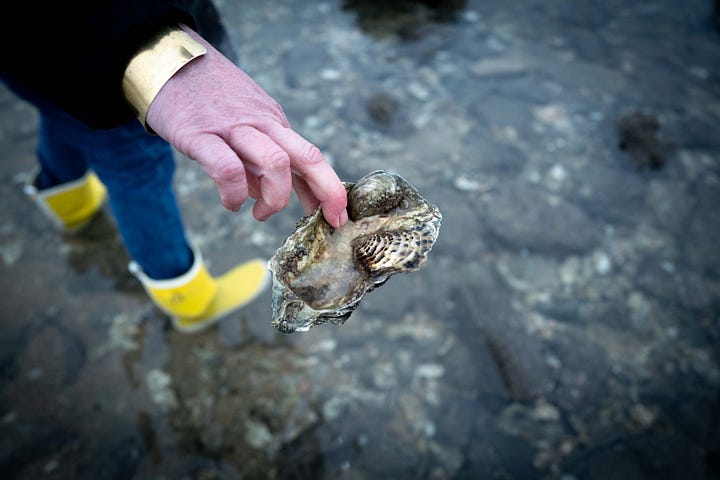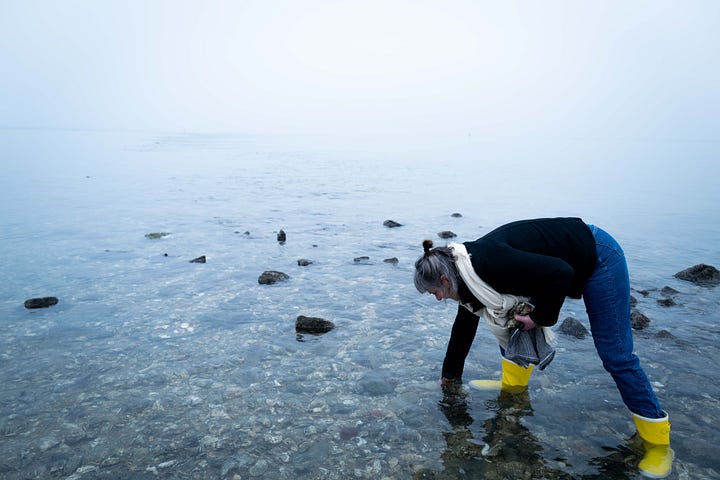Little side note: The audio version of this conversation is in Dutch.
But here on the Substack, there is a summarized written English version and photos to get a better idea of what we're talking about.
You'll also find Natalie's details—check out her workshops; they are absolutely worth it.
A few weeks ago on a very grey, cold morning mid-December, the sun hadn't risen yet and I found myself at a gas station surrounded by the sounds of morning traffic and the smell of gasoline—not the ideal spot to go foraging. Because that was the plan of the day, foraging with Natalie Schrauwen.
Natalie is someone I love collaborating with; her knowledge of Wild Foods and Fermentation always triggers me to want to go outside and learn more.
Instead of going for a walk in the woods, she suggested we'd drive to the coast to discover the edible treasures of the Oosterschelde at one of her favorite spots to forage Wild Oysters and Seaweed.
So happy with her suggestion. It was amazing to see and taste the diversity of seaweeds this bit of Dutch Coast has to offer.
This conversation is more than a masterclass in coastal foraging; it's about slowing down, enjoying being outdoors, and finding poetry in the winter sea.
I hope you enjoy this conversation and look at that grey body of water a little differently next time because beneath all that grey there's a hidden garden of flavor waiting to be discovered.
Let it trigger you to put on your rubber boots, thermal underwear, and get outdoors to explore.
The audio isn't perfect in the beginning as we are still in the car, but no worries, it gets better after a few minutes.
Enjoy!
A Winter's Feast
"Is this where I can trade the gas station for sea air?" - I ask Natalie when she picks me up at a noisy, smelly gas station near Antwerp early one cold December morning.
"Let's go."
She took me to one of her favorite places to forage oysters and seaweed along the Oosterschelde, by the Dutch Coast.
“Have I been here with you before?” - I wonder.
"No, don't think so. I keep driving around to explore even better spots in this area. But this remains one of my favorites," Natalie responds.
"I was here last year at sunrise in winter with a friend. Mid-winter, brutally cold. The wind was so sharp it made your face feel like cardboard. But it was magical – the front section of the water was frozen. Sea water with ice. That's something special."
"We're truly in the middle of nowhere. I can hardly believe there's sea beyond that hill. But there is."
"We're approaching Putti's Place," Natalie explains. "It's actually a diving hotspot in the Oosterschelde. When conditions are right – good weather and the water temperature is a bit warmer – you'll find lots of divers here during low tide."
"Which is nice because they know many creatures I don't. Last year we found something I'd never seen before, and I hope we find it again today. The flamingo flatworm. Really, so beautiful the way it's almost dancing, it moves just like a flamenco dancer with those ruffled edges."


The Oyster Hunt
"For oysters, we need to be quick. At low tide the water normally goes all the way to that brown stripe you see in the distance. But it's already rising again, so we need to move fast to catch a few."
"And these are truly wild oysters? Not farmed beds?"
"These are wild oyster beds. It's actually a fascinating story – there used to be European flat oysters, but they were hit by disease. So they imported Japanese oysters, which became so successful that you now find almost exclusively Japanese oysters here. If you ever find a true European flat oyster in one of my classes, you get a prize. Because it's so rare. I've only found two in all my time foraging."
With pollution, it's important to check the water quality where you are foraging. I wouldn't just do this anywhere.
It takes 5 to 7 years for an oyster to mature into one ready to eat, so that's a long time for it to be exposed to its surroundings. Because they are in their own substrate most of the time.
Foraging in contaminated water would be like picking mushrooms in Chernobyl.
"Do you want to try one?"
"Sure, I'm not going to say no to that. Better than a bowl of cereal."
The Oysters are firmer and saltier than store-bought ones because they come straight from the sea. The water here is 3% salt – quite salty, but that's what gives them their complex flavor.
In winter, as protection – look at it as a natural anti-freeze – they produce glycogen, making them sweeter. Making winter one of the best seasons to forage here. Most winter vegetables do the same; that's where typical winter vegetables like beets, parsnips, pumpkins get their sweetness.
The season matters too. "Just like land plants, seaweeds -and oysters have seasons. In winter, they produce glycogen–developing sugar as a natural antifreeze, just like winter vegetables such as beets and parsnips. That's why they taste sweeter now."
"It's fascinating, right, how this is typically seen as such a luxury product, but when you learn to forage and know what to look for, it's just... here. Free."
"Yes, and the environment, being outdoors adds to the flavor. I always say where you eat something, your surroundings, the company is an extra ingredient," I add. "Every time I eat oysters now, I'll think of you and this moment. It also amazes me that here we only see oysters, nothing else, no seaweed, just oysters."
Natalie explains that in the sea everything has its place and they're not as adventurous. For that reason, seaweed likes to anchor to rocks.
The Seaweed Garden
As we get closer to shore, Natalie starts pointing out different types of seaweed. There are three main categories: brown, red, and green.
"This is wakame – people think you have to buy it in organic stores or that it comes from Japan, but it grows right here."
She shows me the finger-like structure with what looks like a small flower on top.
"Is that what makes it float?" I ask.
"No, these are actually the 'roots' – though that's not quite the right word. It's the anchor or claw-foot that keeps it attached.
Seaweeds don't need roots like regular plants because they don't extract nutrients from the ground. They get everything they need from the water through their leaves. This is just to keep them in place."
Bladderwrack– we all know it as decoration on seafood platters – looks like tiny puppets with their pairs of bubbles. "Like little boobs," we laugh.
Fun fact: these brown seaweeds turn bright green when dipped in boiling water. They are generally pretty chewy and tough but are great for making seaweed stocks. Or add them to your bath to soothe skin issues. The red seaweeds become almost fluorescent orange when they break loose.
In this part of the world, all seaweeds here are edible – with the exception of vinegar weed, which I've never seen, and as the name suggests, you would taste it immediately," Natalie explains, "though not all are equally delicious."
In between the wall of brown seaweed, we find a bright green covered rock. This hollow and fresh green seaweed is Gut Weed (Ulva intestinalis), tasting remarkably like a fine green tea.
Each variety we taste brings a new surprise: some taste of truffles, others of pepper, and some have textures that remind me of noodles or even candy.
The Changing Seas
Our conversation turns to ecology as we explore the tidal pool.
"This pool never completely empties," Natalie explains. "The slightly warmer water creates a unique environment where different seaweed species thrive together and it makes it easier to see what you're harvesting."
"Seaweed works like mushrooms, with spores," as we discuss coastal restoration. "They often impregnate ropes with spores and hang them in the water. But you need the right structure for the spores to attach to – not sandy coasts, but stones or other objects. Everything needs to be natural materials.
She tells me about the Oosterschelde lobster becoming sterile, possibly due to certain building materials used in dyke construction.
Even the wind turbines out at sea affect things, I add. People think they're purely ecological, but they change water flow patterns and create temperature variations. We think we're creating something ecologically beneficial, but it's also contributing to warming the sea water and impacting marine life."
"Ecology is so incredibly complex," Natalie reflects.
The most important thing to do is get out and learn where your food comes from. The more you know, the more you appreciate it and want to protect it.
The Art of Responsible Foraging
"I don't believe in foraging as free food or as an act of rebellion," Natalie states firmly. "It's a lifestyle that brings you closer to nature and food. Small quantities, real food with more genuine nutrients – but not grabbing. We live in such a grabbing culture."
The regulations reflect this need for balance. In the Netherlands, you need a permit to harvest seaweed. Belgium's rules are less clear, but with more polluted coastlines and fewer rocky areas, foraging there requires extra caution. This contrasts with Scandinavian countries, where regulations are more relaxed due to the abundance of nature.
A Feast of Discovery
Throughout our morning, we taste an extraordinary variety of seaweeds:
A truffle-flavored variety that starts with an oyster note and finishes like mustard
"Blunt reindeer antler seaweed" (a name that makes us wish we were on the seaweed-naming committee)
Slimy dragon tongue seaweed, with a texture like bacon and a sweet-salty taste reminiscent of eel
Various noodle seaweeds that could be briefly cooked and used like pasta
The Therapeutic Sea
"I love the fact that this type of foraging is best done in winter; even on a gloomy day, it's beautiful and so peaceful I don't feel like going back to Antwerp."
"The presence of water has something soothing for the human soul." The fact that you can see so far, and even on a grey day like today, it's pure poetry – so many shades of white and grey blending endlessly, a painting.
The wind, too, plays its part. "It's like turning music up loud," she says. "It clears your head completely."
We've only encountered three other people all morning. Nobody else had the idea of an oyster breakfast on a Thursday, and that's exactly what makes it perfect. In just half an hour, the tide has completely covered our oyster foraging grounds from before. It's amazing what you can find in such a short time – we've only walked about 25 meters or so.
"If I were a prehistoric human," I say, "I would have loved living by the coast. There's always food here." "Yes, though I would have wanted an oyster knife," Natalie laughs.
"If you're prehistoric, you'd figure out how to use a stone. Or another oyster shell!"
We agree we're two lucky people and there's no such thing as bad weather – just bad clothing choices.
The next time you see the sea on a cold winter's day, remember: beneath those grey waves lies a forest of flavors, waiting to be discovered by those who know where to look. Just remember to check the tide tables first.
Or even better, join one of Natalie's foraging workshops – you won't regret it!
In the episode, I talk about Patagonia movies about re-wilding seaweed here’s the link to those;
















